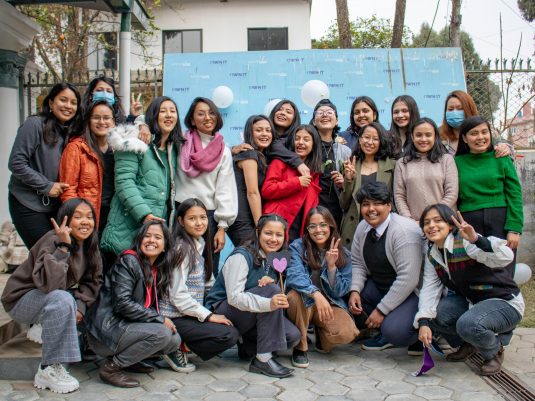2023 Alumni Spotlight: Mega Maskey
- 18 January, 2023
We asked our 2020 YWPLI alumni Mega Maskey important questions about environmentalism and climate crisis in Nepal.
Read and find what she has to say!

2020 YWPLI alumni Mega is a civil engineering graduate by education and an intersectional environmentalist by passion. She runs a youth-led environment coalition called ‘Harin Nepal’ in her capacity as the Network Coordinator. She is also a Shaper at Global Shapers Kathmandu Hub. Mega engages herself in climate activism and advocates for building momentum for climate action, gender equality, and strengthening democracy.
Climate change is a complex and multifaceted issue that has wide-ranging impacts on our society and environment. It is a pressing concern that requires immediate attention and action. Conversations around climate change are noticeably absent in our political and everyday discourse. Why is this? What needs to change?
“Nepal heavily prioritizes infrastructural development without much sustainability analysis. Typical political discussions are built around 3Cs- construction, cement, and corruption as development is viewed synonymously with the construction of roads, bridges, view towers, etc. Then the common narrative that comes along with it is that “a small price of nature is inevitable for the greater good”. The ones who oppose traditional methods and advocate for “binash bina ko bikash” are labeled as “bikash birodhi”. And this is the last thing politicians want to be called. So even just for the sake of maintaining their reputation and public relations, conversations are not done regarding the environment.
Climate awareness is also greatly missing from the curriculum, the entire system, and hence, from the mindset of the people. Incompetent so-called “leaders” are placed in decision-making positions, who neither understand the gravity of the climate crisis nor do they have the capacity to deal with it. The policies and implementations are based on the whimsical decisions of the politicians who do whatever they deem beneficial to them. It is further aggravated by the hierarchical trend of the ever-transferring government that only seems to use the Environment Ministry as a stepping stone to reach other more powerful and influential ministries. Hence there has never been a substantial impact in this department. The policy-making table lacks experts having sound knowledge about the climate and environment and can make actual contributions to the sector. A good example of this is MP Prem Bahadur Ale, who said “trees give out carbon dioxide.” Real experts and academicians are trampled over by attendants with more political connections who cannot best reflect the climate scenario and thus, it never truly gets the attention it deserves.
I believe people are also not educated enough about climate change. On one hand, there is a group of people who blatantly deny that climate change is real, and on the other hand, another group does not see it as a pressing issue. This is because they either “believe” that the consequences of climate change won’t be so dreadful; that it won’t affect them personally; or they are equipped enough to handle it. However, the real challenge is within the rural areas of Nepal, which despite having the lowest carbon footprint, are the first to be hit by climate cruelties, and are often excluded from climate discussions. One aspect is that information is not disseminated across the most vulnerable groups and the other is that they cannot afford to bring climate considerations into their everyday life. You cannot ask the villagers to not cut and burn firewood if that is the only way they cook food. Similarly, you can’t ask city people to abandon their private vehicles when public transportation is not robust. Institutional capacities must be strengthened and effective alternatives must be placed along with proper training to utilize the new resources. Otherwise, all the talk about climate change is just redundant which won’t take us anywhere.”
Climate change affects everyone, but it can have a disproportionate impact on certain groups of people, including women. In your experience, how and why does this happen? How can these issues address this issue in a way that is equitable and takes into account the needs and rights of all individuals, including women?
“Communities that depend on natural resources for their livelihoods like agriculture, tourism, and fisheries bear the brunt of the impacts of climate change. In Nepal, especially among rural settings, indigenous communities and women constitute the majority of these vulnerable groups, and gender-based inequalities with intersecting discriminations like sexuality and disability further aggravate climate impacts on such groups. Men have a larger carbon footprint than women by 16%, and yet, 80% of the population affected by climate change are women. Groups contributing the least to global emissions are often the foremost victims of climate change. However, they are also frontline climate warriors, as it is evident that major environmental movements have been led by women both globally and locally. Similarly, despite being 5% of the world’s population, indigenous people protect a third of the world’s forests.
As the climate emergency continues to make an impact on our environment, the natural resources it provides our communities will become scarcer, thus challenging the basis for their livelihoods. This brings added pressure on women to fulfill their domestic roles, which not only prevents women from focusing their time and energy on more economically and personally productive activities but also deprives them of their basic rights. For example, water scarcity compels women to travel farther to collect water, deforestation has made it difficult for women to source for fuel wood. This leads to a perpetual cycle of poverty and increasing vulnerabilities.
As a domino effect, this position of vulnerability thrusts them into increased levels of intimate partner violence. There is ample evidence from across the world that suggests that men show a marked increase in violent behavior stemming from environmental pressures that threaten the balance of their daily lives. The ICIMOD data suggests that in Nepal, an estimated 12,000-20,000 women and children are pushed into forced labor and sex every year, and trafficking increases by 20-30% during disasters. Nepal is already plagued by malnutrition and food scarcity problems, which are heightened by the climate crisis. This further leads to infant mortality and reproductive health problems in women entrenching them deeper into agony. Moreover, the school dropout rate of children also considerably increases when hit by climate-induced events as they have to work harder to provide for their families. Young girls, on the other hand, are married off to better cope with poverty, leading to increased child marriage and early childbearing rates.
Agriculture is the prime occupation of Nepal as well as the most climate-sensitive, where 61% involved in subsistence farming are women. Women also have limited access to timely weather forecast information which affects their options for farming, they lack independent sources of income and may be unable to access credit. This invariably makes women more dependent on the productivity of the land. Women’s activities in food production, community management, natural resource and biodiversity management, education of children, and family care place them at the center of development. Yet only 25.7% of households are headed by women, and females own neither land nor house in 80.1% of households is a testament to the stark asymmetry between women’s workload and decision-making authority. Women thus bear a greater burden of work, but men enjoy the privileges of access and control over resources and decision-making authority that women are generally deprived of.
Economic empowerment of women is very necessary because Women’s agency and decision-making powers are largely dependent on their economic resources. Economic empowerment translates into women having more space to make decisions for the well-being of themselves, their families, and their communities. Also, women are generally underrepresented in climate change policymaking and negotiations at the community level and beyond. Just 26.8 % of government ministers responsible for policies on environment and climate change are women, while 73.2 % are men. It is also evident from the 2022 general elections, where only 9.2 percent of the total 2,536 candidates contesting the 165 lower house seats were women. It is important to increase resilience among women in climate-vulnerable communities by way of gender-responsive interventions, specifically through engaging, educating, and empowering to transform inequitable gender relations both at an individual level and a systemic level as well.”
How does climate change affect Nepal particularly?
“Nepal has a unique topography that varies from low-lying areas in the south with elevations less than 100 m to the world’s highest peak at 8,848 meters. This makes the country especially susceptible to a variety of climate issues from every facet, making Nepal the 11th most vulnerable to climate change in the Global Climate Risk Index 2022. Nepal ratified the Paris Climate Agreement and its Second Nationally Determined Communication (NDC) in 2020, which the country should abide by but has evidently failed to.
The global average temperature is set to exceed 1.5°C by the turn of the decade. The Himalayas will get hotter faster than other parts of the world because of their proximity to the equator and could warm by 1.8-2.2°C. Scientists say the Himalayas are already warming up to 0.3-0.7°C faster than the global average due to ‘Elevation Dependent Warming’. But at the current trajectory, the mountains may see warming of up to 5.7°C during this century. In such a scenario, the Himalayas will lose two-thirds of permanent ice. Even if global heating can be limited to 1.5°C, around 36% of the glaciers in the Himalayas will vanish by the end of the century.
For Nepal, even a 1.5°C rise in global temperature will mean heavy precipitation and associated flooding. At a 2°C increase, the floods, heat waves, and droughts will be even deadlier. An increase in soil erosion, landslides, flash floods, and droughts has been reported in recent years across the country, with increased intensity and impact on the lives and livelihoods of the Nepalese. Modeling has suggested that the number of people annually affected by river flooding could more than double by 2030 as a result of climate change.
At the same time, the economic impact of river flooding could triple as the return period of flood has reduced to a few years from a decade. The average annual economic loss from climate-induced disasters is about 0.08% of GDP (2018/19), whereas in extreme years like the 2017 Terai floods, the economic loss and damage from this single disaster event were around 2.08% of GDP (2017/18). Around 80% of Nepal’s population is at risk from natural and climate-induced hazards. During the last 40 years, natural disasters have caused close to US$ 6 billion in physical and economic damages in Nepal alone.
It is important to note that in Nepal, about half of greenhouse gas emissions come from the agriculture sector, followed by energy, land-use change and forestry, industrial processes, and waste. In the last decade, employment from agriculture has reduced to 60% from 75%, and contribution to national GDP has reduced from 35% to 27%. The national loss in food production is expected to be 5.3% towards the end of 2020s. This further adds to food insecurity that can be credited to the change in the cropping pattern and unusual seasonal changes in temperature and precipitation.”
What kind of future do you envision for Nepal? How can it be achieved?
“I envision a Nepal that is clean, green, sustainable, and equitable. I hope for a country that is led and run by women challenging the gray old recycled men in power. It should also cater to disadvantaged groups and bring inclusion for a truly democratic and participatory government. A future where infrastructural projects do not clash with nature, bringing in green designs, sustainable construction, and development planning according to the need and situations of the surrounding. A place not only for humans but for all species, upholding integrity in biodiversity. My version of utopia serves climate justice, racial justice, gender and caste equality, human rights, accessible health, and an education system for peace and prosperity.
However, these are all grandiose abstracts of what Nepal should ideally look like. Our job as youths is not to tell them how to achieve this, but rather to raise our voices and demand the heads who have taken responsibility for the nation. The representatives that we have elected should stick to their promises and bring experts to the table who can actualize their manifestos. Our constitution, laws, and policies are almost picture-perfect, it just needs to be implemented efficiently. And if they cannot do so, they should be ready to pass on their legacy to the next generation.”
As regular individuals, we often feel a great deal of the burden of climate change but feel helpless and don’t know how to contribute to combating it. How can individuals make an impact?
“I feel that individualism is often glorified in a way to divert our attention and energy from the actual source of the problem. Just 100 companies are responsible for 71% of global emissions, and yet overpopulation is proclaimed as the biggest threat to climate change. The fault and guilt are repeatedly pointed towards individual choices, whereas major polluters masquerade themselves with a facade of greenwashing tactics. Our individual action should be directed towards challenging such corporations, asking for accountability from world leaders and governments, and demanding investments in real solutions, mitigation, and adaptation. Policy making and implementation is the most efficient way to combat climate change (while leaving space for grassroots mobilization and innovation), so I believe individuals must strive towards actualizing that purpose of action. Having said that, it is also important to walk the talk by ourselves. Simple acts like minding your energy consumption, managing your waste, and buying and consuming consciously, may not change the world, but they will certainly make our surroundings more livable.
It is also important to note that not everyone can afford to make these individual choices. Climate change has become an elite-centric issue that is being capitalized as a hot money topic. Eco-friendly products and interventions are mostly catered towards the higher earning class of society, be it through pricing modules, marketing, or the overall mechanism. While we should appreciate their efforts towards a sustainable lifestyle, it is important not to shun the working class who are forced to toil away in environmentally unflattering jobs, or use unsustainable approaches if a better, more practical, and economical option is not provided.
Climate change is indeed terrifying but regular individuals should just do their part of the duty without feeling burdened on how to combat it. They should educate and update themselves on climate issues especially affecting their locality, and start awareness dialogues in their network. Join a climate strike or protest happening nearby; or attend events and programs on environmental topics; share climate information on your media handles. There are no set norms that we should follow, but fairly do what is feasible on our end and integrate our unique skills to stir the climate world.”
What motivates you?
I am compelled to work in the field of climate change because it demands urgent action. I get eco-anxiety imagining all the climate crises knocking at our doorsteps. Glaciers melting, rivers flooding and forest depletion scare me to my core. When I first heard Nijgadh Int’l Airport was being constructed, I couldnt sleep all night. We have entered the age of the sixth mass extinction with an ecological crisis unfolding globally, and the impacts of climate change are rapidly becoming irreversible. So it is high time and possibly the last chance we have to preserve what we have left of Earth for the present generation and regenerate it for future generations. But we have failed again and again, which is why activists like us have to step in. I would probably not if I didn’t have to, but the situation calls for it, and I guess you could call that my source of motivation.
Where does Women LEAD fit into your personal and professional development?
“Women LEAD has played a big role in helping me understand the essence of feminism and hence, in defining me as an ecofeminist that I call myself today. Gender and climate have always been the two most core ideas to me, but Women LEAD illuminated the path in which I could take both simultaneously in a way that complimented each other. Watching the empowering team of Women LEAD, my amazing co-fellows and equally amazing alumni helped me unlearn and relearn the real meaning of female leadership. I realized that maybe the key to combating climate change and the prosperity of the nation is women. It sparked a curiosity in me to learn more about the intersectionality of climate with gender, and now my entire activism is based on that. Viewing everything from a gender lens, from simple conversations to integrating gender considerations in my projects, I started with Women LEAD.
As a fellow of YWPLI, Women LEAD showed me the role and importance of women not only in politics but also in running family, office, business, and every other aspect of life. It is here that I first experienced women truly supporting women, and what women in power can and have been doing. Learning never stops and it is especially true if you are an alumnus of Women LEAD. The incredible opportunities, network, and exposure that the institution provides have greatly elevated me both personally and professionally. Moreover, Women LEAD has unconditionally backed my requests, projects, and other endeavors, and also supported me emotionally, and in return, I make sure to give back my best to society and Women LEAD in any way I can.”



